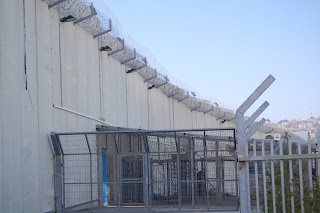
We first stopped for some coffee before going to the shepherd’s field (where the angels appeared to the shepherds, who were of course guarding their flocks by night). While enjoying our Arabic coffee, we noticed a tight cluster of very new-looking apartments on a hilltop, surrounded by a fence. Our tour guide informed us that this was another Israeli settlement, which was heavily guarded, as Israelis are persona non grata in the West Bank. A man stringing Christmas lights on a nearby telephone pole then shouted, “yeah, and they’re killing Palestinians with your tax dollars”. Eeek, tough crowd.
Tiny shepherds in a Catholic grotto near the fields:

The fields had some nice views, but were otherwise pretty unremarkable, save a church built by some Canadians in the 1960, which features a prominent maple leaf on the alter. Maybe they should add a Wayne Gretzky icon to class the place up a little further.
Now, on to the Church of the Nativity, which was built on the site where Jesus was born. Again, the story of a Byzantine church destroyed, Muslims taking over, and Crusaders rebuilding repeats itself. The main entrance, now called the “Door of Humility”, was actually made tiny to prevent locals from coming in with their carts and looting the church. The current church is decorated in Greek Orthodox style, with lots of icons and incense, so it reminds me of church from childhood, although obviously on a much grander scale. Adjacent to the main church is the “milk grotto”; the walls of which turned white when a drop of Mary’s milk fell. The fact that the grotto is made of chalk is a more secular explanation. There is a huge collection of letters from women who could not bear children, and after drinking a little of the chalk and praying, they conceived. Can’t argue with results. A bargain at $2 per bag!
Bodyweight squats at the Door of Humility:

Some nice stained glass:

Crusader mosaic icons:

We had originally planned to come back to this church for a midnight service on Christmas Eve, but after talking to some locals, apparently you have to show up many hours in advance, put up with hassles at the border, and have to be ever-vigilant for pickpockets, so we decided to just got to a church in Tel-Aviv instead.
That pretty much concluded our visit to Bethlehem. After visiting Jerusalem, Bethlehem wasn’t much to see, though the church was nice, and it was interesting to see how different the culture was on the other side of the wall. We recently read a Time magazine article about how the wall has dramatically decreased bombings since its erection, but it has further divided the Israelis and Palestinians. When asked what an Israeli looks like, most young Palestinians describe a person in fatigues holding an M16, as the guards at the border are the only Israelis with whom they’ve ever come into contact. Now, the majority of young people report that they cannot see a peaceable settlement of the land disputes. Not a great sign when the younger generation is much more conservative than the older.
In a different note, I went to the lab for the first time since before Christmas and was greeted with a big pile of Christmas cards! Thank you so much to everyone who sent them, it was great to hear from you.
We received cards from the following, and if you sent and you’re not listed, fear not, mail is extremely slow:
Grandma
Leslie and Rich
Holly and Karl
Mom, Dad, and Justin
Aunt Patsy and Uncle Mike
Aunt Kiki
Carole and Andy
Furahi mwaka mpya! (Happy New Year!)
M
More places and names previously only read in the Bible stories, and the sense of conflict appears to have been pronounced. I wonder how that effected your impression of the coming Christmas Eve services? It must be difficult to consider Silent Night, Joy to the World, and other Christmas music when the conflict between ancient peoples is so vivid?
ReplyDeleteThank you for sharing this part of the world which is so skewed in the American press, and which divides people here nearly as much as it does there. Once again, you saw firsthand how cultures merge and collide in various sequences and with very strong outcomes.
Wishing peace ahead in this troubled, holy land.
Love,
L/Mom